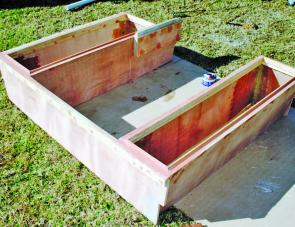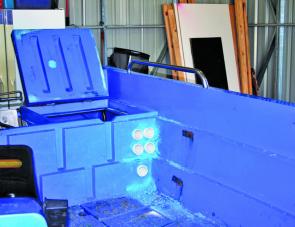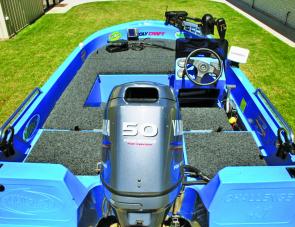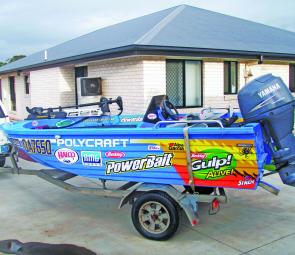Straight from the factory, the Polycraft 4.1 is a versatile fishing machine. I purchased my first Polycraft second hand just over a year ago. The boat was fitted with a 50hp four stroke Yamaha. With some remodelling, I turned the boat into a tournament style boat with loads of dry gear and rod storage.
Before buying my boat, I had fished from a Polycraft on numerous occasions and the benefits were clear. Their plastic hull provided a soft ride due to its ability to flex through the chop dished out by rough conditions. The doubled skinned hull provided a solid and quiet platform unlike that found on noisy aluminium boats. This stealth feature made it easy to sneak up on spooky fish and the whole fishing experience more pleasant. The double skin and thick construction makes poly boats quite heavy. This weight is actually an advantage in smoother water as the boat is very stable at rest.
It wasn’t until I started to work on fitting out my own boat that I discovered there were more benefits. The boat had done quite a few hours on the water and despite a few scuffs and gouges in the plastic it showed no signs of serious or permanent wear. Tinnies of the same age could have had electrolysis, dents or even cracked and repaired welds.
The plastic used in Polycraft boats is very easy to work with and repair. Small to medium sized holes can be welded using a soldering iron. I repaired dozens of screw holes and moved the navigation lights which required the repair of two 20mm holes. One section of the boat had been scuffed by rubbing against something and it was simply a matter of having it heated with a heat gun to melt the rough finish. Once this plastic hardened, the whole hull was sanded and buffed to look like new. Unlike the painted finish on other boats, the colour is uniform through the thickness of the hull meaning scratches don’t stand out too much.
The plastic is very easy to cut and drill. I installed some new inspection ports using a jigsaw and holes for the livewell fitting and rod locker tubes were made using a cheap hole saw. I have carried out the same work on aluminium boats before and it required expensive drill bits and quite a bit of sweat.
My aim in remodelling the boat was to turn the Polycraft in a tournament style boat. This meant the boat would need a forward and rear casting deck with storage and also a rod locker. From the factory, the boat can be fitted with smaller decks front and rear but I chose to extend them both as this is where we spend most of our time in the boat (standing and fishing).
Luckily the length of the steering cables and wiring allowed me to move the drivers console to the desired position. With a quick measure and a few drawings it was time to construct the storage compartments and rod locker. Polycraft boats tend to expand and contract in hot and cold weather. Rather than fixing the hatches straight to the hull, I decided to make a drop in section.
Instead of opting for heavy duty materials which would weigh the boat down, I chose to use light plywood which could be reinforced with fibreglass. The ply boxes were constructed from 12mm and 6mm structural ply and I created a lip to channel the water from the decks away from the storage openings. The lids were given a rolled edge to fit over this lip - effectively creating waterproof storage compartments. Chopped strand mat and fibreglass resin was used to strengthen the boxes paying particular attention to any joins. After a quick sand, a coating of Flowcoat sealed the job and gave it a nice, easy to clean finish. The outside was painted with some exterior paint which was colour matched at my local Thrifty Link Hardware store. The finished product without the lids was quite awkward to handle alone but was very light and dropped into the boat neatly. Before securing it to the hull and fixing the driver’s console in place, I carried out some other modifications.
The 4.1 Challenger comes standard with two large storage areas in the front and two plus bilge access in the rear. The two front hatches are used as a livewell and lifejacket and wet weather gear storage while the back ones give access to the fuel and cranking battery.
The drop in insert gave two large storage areas for housing the electric motor batteries, tackle and any other bits and pieces. These hinged lids are held in the closed position by stretch loops and I plan to add cam locks for keeping valuables safe.
The whole front deck was padded for angler comfort. I spend a lot of time fishing barefoot and after a few days end up with sore, bruised feet. By gluing 10mm high density foam under the carpet, I made the platform very comfortable to stand on. Two swivel seats are mounted in the rear platform for when the boat is moving. These can be pulled out and placed in the cockpit to give the angler fishing from the rear platform more room or placed in mounts with pedestals on the front and rear decks to allow anglers to sit down and fish.
The rod locker runs down the passenger side with the rod tips feeding into the rear of the boat where the fuel tank is situated. To protect the valuable rod tips from the tank sliding and crushing them I inserted sections of PVC into the rear compartment. The poly was drilled with a hole saw and the PVC pushed into place. To hold everything in place I used some heavy duty zip ties.
The 4.1 Challenger has two large storage hatches on the front deck. One is often used as a livewell and I chose to upgrade the existing one to a Flow-Rite system. This job required some thought and an inspection port hidden in the livewell to gain access to the double skinned hull.
The Flow-Rite system 4 setup allows controlled water movement via a dial positioned near the cockpit. With empty, fill and recirculate positions the dial controls a valve mounted to the livewell pump in the bilge area. It’s simply a matter of flicking a switch for the pump and turning the dial to the desired position while you’re sitting in the driver’s seat. I gave the livewell a pump-out aerator nozzle which diverts the water pumping into the livewell out through a separate line to a thru-hull fitting in the side of the boat to speed up the emptying process.
The fuel storage area in the rear port corner is capable of carrying a 28L fuel tank as well as two spare 10L containers. This keeps the 50hp Yamaha four stroke ticking over for many hours of fishing.
I believe there’s no point mucking around when it comes to electric motor power. The weight I had saved by keeping the casting deck and storage insert light was soon taken up by a second battery. The 24 volt setup powers an 80lb thrust Minn Kota cable steer electric. Two deep cycle Trojan 130Ah batteries supply the power to the electric motor. Running the motor on 24 volts draws fewer amps and effectively gives it a longer running time. Rarely is full power required unless the boat is used in electric competitions, electric only impoundments or in strong currents and wind. The 80lb thrust motor may seem like overkill but in some conditions the power it delivers really pays off. To be able to hold on top of fish in adverse conditions can make the difference between catching them and missing out. The pair of Trojan batteries can deliver several days of fishing on a single charge when conditions are ideal.
My rebuilt Polycraft sports two sounder units - one at the front on the casting deck and the second at the driver’s console. I chose to mount the unit at the console in a position so it could be viewed from anywhere in the boat by swivelling the mount. This gives the front deck a second sounder to view which is handy in case there is ever a problem with the front sounder or transducer.
The front sounder is a Humminbird 787 with GPS and the one at the console is a 798ci with built in GPS antenna and side imaging ability. These two colour units are exceptional and help make the boat a fish catching weapon.
There is no better way to test anything than in the field in action. After a year of fishing and countless kilometres on the trailer and in the water, the boat is still in top shape and I love it even more than the first time I set foot in it. I have owned many similar boats in my time and would have to say that the Poly is by far the most affordable and practical of them all. It would be hard to find a better 4.1m boat on the market. The plastic hull can take a bashing against rocks and can be beached anywhere. The boat has tackled skinny creeks, big dams, estuaries, bays and the open ocean. The ability to launch it where there are no ramps has placed it in areas where larger trailer boats would never dare to enter yet the stability at rest and powerful electronics makes it a force to be reckoned with in bigger waterways.
I have ventured out to sea about a dozen times and provided there isn’t too much chop the boat is safe. The heavy hulls are not the best for bar crossings or big seas and I wouldn’t recommend taking on anything too serious unless you have a lot of experience. Having said that, there is only so much any 4m boat can handle. The only other fault the boat has is that stickers don’t stick to it all that well but at the same time this makes cleaning the hull a breeze.
Reads: 22032
This light ply insert is waiting to be strengthened with fibreglass. With lids, the insert creates a forward and rear storage hatch and a rod locker.

Poly pipe is mounted into the fuel hatch to accept rod tips and protect them while in the rod locker. These poly tubes are held in place with heavy duty zip ties.

The Challenger deck layout provides storage and deck space aplenty.

The 4.1m Polycraft Challenger can even be dressed up to look like a flashy tournament boat.




